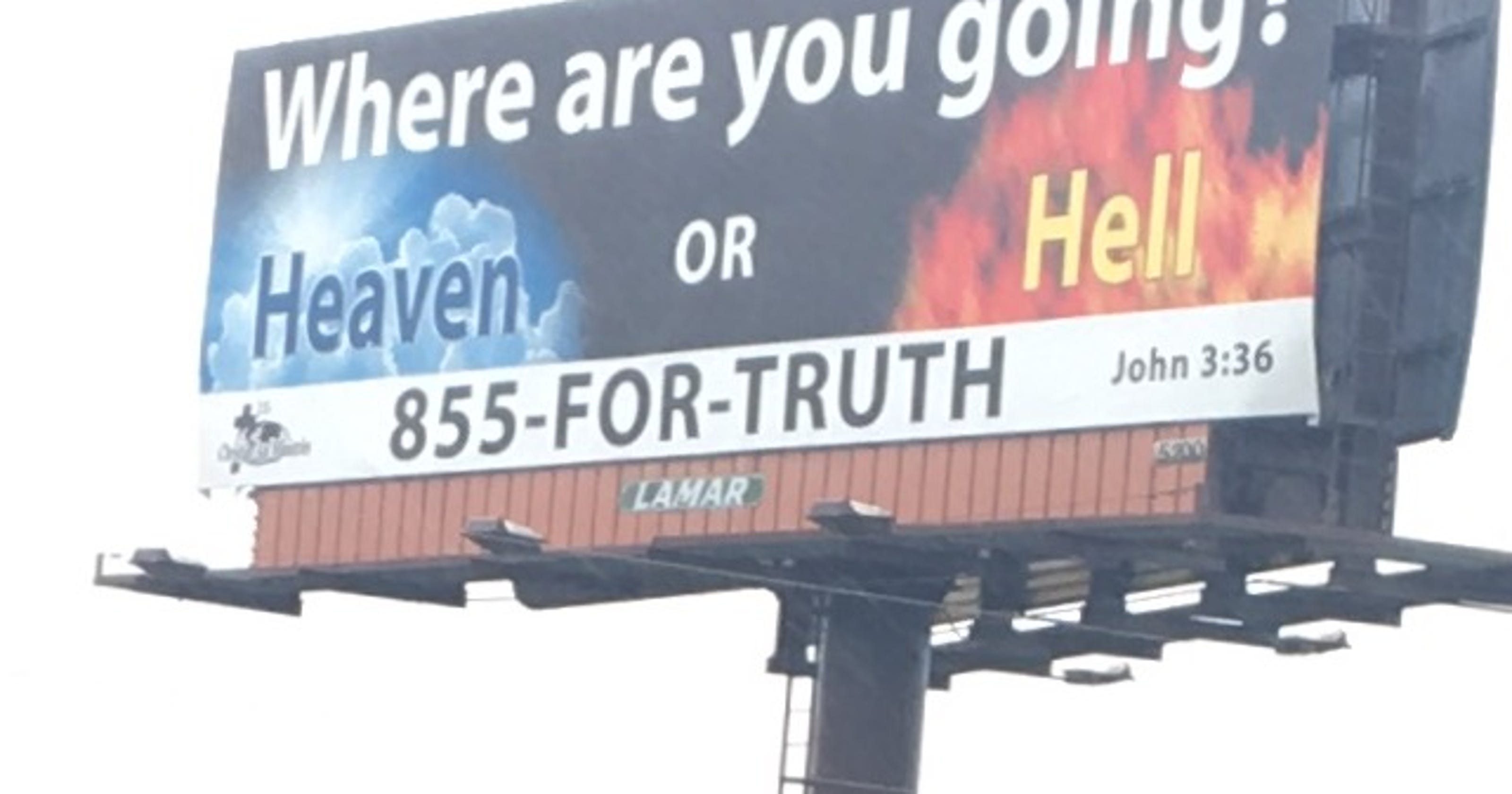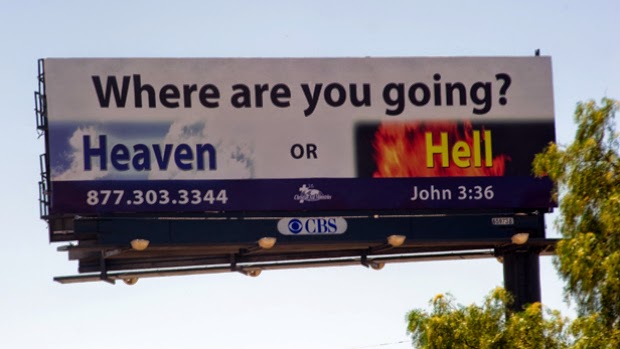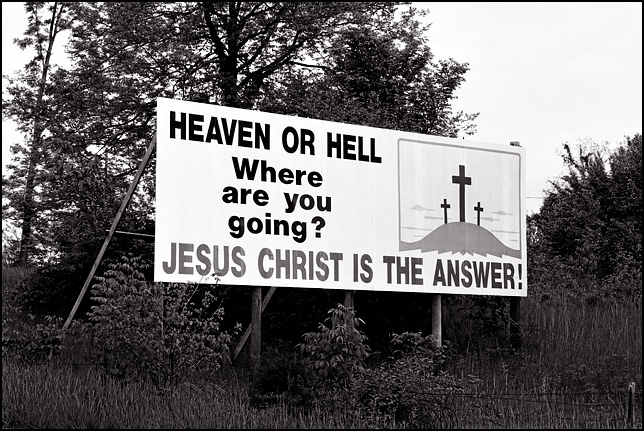Have you ever been driving along, perhaps lost in thought, and then suddenly, a massive sign catches your eye? It's that moment when you see the "are you going to heaven or hell billboard" standing tall by the road, a really striking sight that often makes you pause. For many, this kind of public message, often quite direct, can spark a moment of deep reflection or, you know, just a quick thought as you pass by. It's an interesting part of our shared experience on the highways and byways.
These signs, asking where you might be headed, are actually not a new thing at all. As a matter of fact, for many decades, various people and faith groups have used these very visible spots to get their messages out there. They understand that a big sign by the road can really reach a lot of folks, and that, is a powerful way to share what they believe.
The goal behind these billboards, it seems, is often to make people think about big life questions. They're put up to prompt a moment of consideration, maybe even a little self-reflection, about what comes next. So, when you see one, it's almost like a little nudge to consider some really significant ideas, you know?
Table of Contents
- The Enduring Presence of the 'Are You Going to Heaven or Hell' Billboard
- What Do These Billboards Really Ask?
- Different Reactions and Interpretations
- The Effectiveness of Roadside Spiritual Messages
- Why Do These Billboards Still Appear Today?
- Frequently Asked Questions About These Billboards
The Enduring Presence of the 'Are You Going to Heaven or Hell' Billboard
A Familiar Sight on the Road
There's a good chance, if you've spent much time traveling by car, that you've come across one of these thought-provoking signs. You know, the kind that asks, "where are you going, Heaven or hell?" I mean, it's a pretty bold statement to see flashing by your window, isn't it? One person, Mia Pennekamp, recounted seeing such a sign while on a bus, and her initial, almost automatic thought was, "New York?" It just shows how these messages can hit you when you least expect them, often making you think about something far different from your travel plans.
These billboards are often placed in very prominent spots, like along major interstates. For example, just south of Columbus, Ohio, along Interstate 71, there's a really huge one standing in a neatly plowed field. It's a landmark for many, and it definitely gets noticed. So, it's not just a small sign; these are often quite large, designed to be seen by countless drivers every single day, which, you know, makes their message even more impactful.
The visual elements can be quite striking too. A billboard outside Chicago, for instance, depicts "heaven" shining with backlit clouds, while "hell" blazes with raging flames. This vivid imagery is clearly meant to leave a strong impression, making the question about your destination feel even more real and urgent. It’s a pretty powerful way to get a point across, honestly.
Historical Roots of Roadside Messages
The idea of using roadside signs to share messages, especially spiritual ones, has a really long history. It’s not just a modern thing. For many years, people have understood that putting up a sign where many eyes will see it is an effective way to communicate. So, these "heaven or hell" billboards are, in a way, just a continuation of a very old practice, adapted for our modern roads.
Think about it, before the internet, before even widespread television, billboards were a primary way to reach a lot of people at once. They served as a sort of public forum, a place where ideas, products, and, yes, spiritual questions could be put right out there for everyone to consider. This long tradition, you know, really gives these contemporary signs a bit of extra weight and history.
The persistence of these billboards, even today, shows that the underlying principle still holds true: if you want to get a message to a lot of people, put it where they can't help but see it. It's a simple, yet very effective strategy that has stood the test of time, proving its worth for various kinds of public announcements and calls to thought, more or less.
What Do These Billboards Really Ask?
Beyond a Simple Question
When a billboard asks, "where are you going, Heaven or hell?", it's obviously not asking about your travel plans for the weekend. This question goes much deeper, aiming to touch on eternal matters. It's a direct challenge, really, to consider your life's direction and what you believe about what happens after this life. The text often includes a verse, like "he that believeth on the son hath everlasting life, And he that believeth not the son shall not see life, But the wrath of god," which, you know, gives the question a very specific religious context.
The intention behind such a stark question is to provoke thought, perhaps even a bit of unease, in those who see it. It's designed to be a wake-up call, suggesting that there are important choices to make right now that have lasting consequences. So, it’s not just a casual inquiry; it’s a very serious one, meant to get you thinking, in a way, about your ultimate destination.
This kind of messaging often plays on the idea that many people don't really worry about these big questions until it might be too late. The billboard acts as a kind of early warning, prompting you to consider your path now, while you still have the chance to change course. It’s a pretty powerful way to make someone reflect, actually, on their current beliefs and actions.
The Call to Consider
The core message is always a call to consider one's spiritual state. It's an invitation, sometimes a very firm one, to think about where you stand in relation to these eternal concepts. The idea is that by presenting such a direct question, people will be compelled to seek answers, perhaps by calling the number often provided on the sign, or by looking into religious texts themselves. It’s a way to start a conversation, even if it's just a conversation in your own head, you know?
For some, seeing this kind of billboard might be the first time they've really thought about these topics in a serious way. It can be a moment of personal reckoning, prompting them to ask, "How do I know if I am going to heaven or hell?" This kind of direct inquiry is designed to cut through the daily noise and get right to what the billboard creators see as a very important issue for everyone.
So, the billboard isn't just about giving information; it's about stirring up a personal quest for answers. It aims to make you feel that this question is relevant to you, right now, and that you should consider it with some seriousness. It’s a very direct approach to encouraging spiritual reflection, and it definitely gets people talking, or at least thinking, about these profound ideas.
Different Reactions and Interpretations
From Curiosity to Contemplation
The reactions to an "are you going to heaven or hell billboard" can be quite varied, honestly. Some people might just see it as a curious roadside oddity, maybe even a bit funny, like a "cursed bumper sticker decal" as one person mentioned. For others, it might spark genuine curiosity, leading them to wonder about the people behind the sign or the specific beliefs it represents. It's a pretty wide range of responses, you know?
Then there are those who find themselves genuinely contemplating the question. The sight of the billboard might trigger a moment of deep thought, prompting them to reflect on their own lives, their faith, or what they truly believe. This is, in a way, exactly what the creators of these signs hope for – to move people from just seeing to actually considering.
Some might even feel a bit of panic, like the person who "pulled out your phone in a panic, and took a picture at the last possible second." This shows the immediate, visceral impact these signs can have, making people feel an urgent need to capture the moment or grapple with the question right then and there. It's a very human response to such a direct and unexpected challenge, really.
The "Hell Is Real" Phenomenon
A particularly famous example that fits this theme is the "Hell Is Real" billboard, which has become iconic, especially in Ohio. Jimmy Harston, the man behind this specific sign, has shared its origin story, and it even lent its name to Ohio's fiercest soccer rivalry, which, you know, is pretty remarkable for a billboard. This shows how these signs can take on a life of their own, becoming more than just a religious message.
The "Hell Is Real" sign, much like the "heaven or hell" ones, aims to make a strong, undeniable statement. Its very directness is part of its power, leaving little room for ambiguity about its message. It forces passersby to confront a concept that many might prefer to ignore or put off thinking about, at the end of the day.
The fact that such a sign can inspire a sports rivalry's moniker speaks to its cultural impact beyond its original spiritual purpose. It shows how deeply these roadside messages can embed themselves in the local consciousness, becoming a part of the landscape and even popular culture. It's a testament, you know, to the lasting power of a well-placed, provocative sign.
The Effectiveness of Roadside Spiritual Messages
Reaching a Wide Audience
One of the clear advantages of an "are you going to heaven or hell billboard" is its ability to reach an incredibly wide and diverse audience. Unlike a church service or a specific religious gathering, these signs are seen by anyone who drives by, regardless of their background, beliefs, or intentions. This means they can touch people who might never otherwise encounter such a direct spiritual question, which, you know, is a pretty unique reach.
They operate on a principle of passive exposure. You don't have to seek them out; they are simply there, presenting their message to you as you go about your day. This broad, almost accidental, exposure is what makes them so appealing to those who want to spread a spiritual message far and wide. It's a very democratic way of sharing an idea, in a way, since it's open to everyone on the road.
While some might wonder how effective such roadside messages truly are in our more secular times, the sheer number of eyeballs they capture is undeniable. Even if only a small percentage of viewers are deeply affected, the total number of people reached can be quite substantial, making it a valuable tool for outreach, basically.
Sparks of Conversation and Reflection
These billboards often do more than just convey a message; they spark conversations. People talk about them, share pictures, and even debate their meaning and effectiveness. This ongoing discussion, whether online or among friends, extends the billboard's reach far beyond its physical location, you know?
For example, someone might call the number listed on the billboard, as mentioned in "My text," where they might "talked bible stuff and interpretation." This shows that the signs can lead to direct engagement and further exploration of the spiritual questions they raise. It's a clear indication that for some, the billboard is just the beginning of a deeper inquiry, which is really what they're aiming for.
Even if a person simply pauses for a moment to consider the question, that brief reflection can be meaningful. In our busy lives, any prompt to think about deeper topics can be valuable. So, in that sense, these billboards often succeed in their primary goal: to make people stop, even if just for a second, and think about where they are going, more or less, in a spiritual sense.
Why Do These Billboards Still Appear Today?
A Lasting Method of Outreach
Despite the rise of digital communication, the "are you going to heaven or hell billboard" continues to be a chosen method for certain groups to share their beliefs. Why? Because they offer a kind of undeniable presence that digital ads sometimes lack. You can scroll past an online ad, but a huge sign by the highway is pretty hard to ignore, you know?
These billboards are a tangible, physical manifestation of a message, rooted in the landscape. They stand there, day after day, year after year, offering a consistent and unchanging statement. This permanence gives them a unique power, especially in a world where information often feels fleeting. It’s a very traditional, yet still very effective, way to make a lasting impression, honestly.
For the individuals and groups who fund them, these billboards represent a direct and public declaration of their faith. They are often put up by incredibly religious millionaires, particularly Baptists, as one snippet in "My text" points out. This shows a deep commitment to using their resources for what they believe is a vital form of outreach, pretty much.
Modern Interpretations and Art Projects
Interestingly, these billboards aren't just seen in a purely religious light anymore. Their striking nature and the profound questions they pose have made them subjects of artistic and cultural interest. Someone might, for instance, ask where a "heaven or hell" style billboard is located because they "need to record one for an art project." This shows how these signs transcend their original purpose and become part of broader cultural conversations, you know?
They can even become the basis for memes or other forms of digital content, like "funny gen z meme billboard cursed bumper sticker decal." This transformation into popular culture elements speaks to their enduring power to capture attention and provoke thought, even if the context shifts from purely spiritual to something more satirical or artistic. It's a very modern way that these old-school messages find new life.
So, while the primary aim remains spiritual outreach, the "are you going to heaven or hell billboard" also serves as a fascinating example of public messaging, cultural impact, and even a source of artistic inspiration. They continue to appear because they work, not just in spreading a religious message, but also in sparking curiosity, conversation, and reflection in a very wide array of people, at the end of the day. You can learn more about public messaging and its history on our site, and link to this page for more insights into cultural phenomena.
Frequently Asked Questions About These Billboards
What is the purpose of an "are you going to heaven or hell" billboard?
The main purpose is to make people think about their spiritual path and what they believe happens after this life. These signs aim to encourage reflection and, for some, to prompt a decision about their faith. They are put up to get people to consider big, lasting questions, you know?
Are these billboards effective in changing people's minds?
Their effectiveness can really vary. While it's hard to measure precisely, they definitely get noticed and spark conversations or personal reflection for many. For some, they might be a first step towards deeper spiritual inquiry, while others might just see them as a curious roadside sight. So, it's a bit of a mixed bag, honestly.
Who typically puts up these types of religious billboards?
These billboards are often funded by individuals or religious organizations, sometimes by very religious people with significant resources, like certain Baptist groups. They see it as a way to share their beliefs with a broad public audience, using a very visible medium to get their message across, basically.
For more general information about how public messages have been used throughout history, you might want to look at a resource on the history of public messaging.



Detail Author:
- Name : Dr. Verdie Johnston
- Username : karelle.hauck
- Email : madonna.will@gmail.com
- Birthdate : 2002-01-29
- Address : 365 Lynch Mill Suite 377 Townebury, MA 77262-3299
- Phone : (734) 603-0119
- Company : Gibson-Rutherford
- Job : Precision Aircraft Systems Assemblers
- Bio : Quo saepe nulla perspiciatis illo quos. Ea accusantium et aut omnis. Nobis optio illum quos dolores.
Socials
instagram:
- url : https://instagram.com/emelia.dach
- username : emelia.dach
- bio : Error maiores deleniti eum. Deserunt sunt quis et a. Ut sed rerum nam accusamus a laborum.
- followers : 4522
- following : 1654
facebook:
- url : https://facebook.com/emelia_dev
- username : emelia_dev
- bio : Quisquam cumque dolorum nostrum id aut.
- followers : 3068
- following : 622